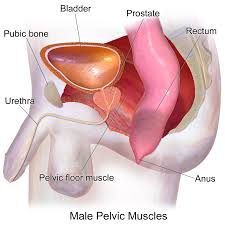Everything You Need to Know About Incontinence After Prostate Surgery
Sep 22nd 2020
According to the National Association for Continence, about 20% of men continue to experience significant incontinence after prostate surgery beyond the six-week recovery period. Don’t be too worried, because that number continues to shrink for up to a year after surgery. Some men simply take longer to recover, a factor that depends on your age at the time of surgery. So, if you’re still experiencing leaks several months after a prostatectomy, no need to be alarmed.
Whether you’re contemplating surgery or are in recovery, you probably have some questions. So here’s what you need to know about causes of incontinence after prostate surgery and how to regain greater bladder control.
Reasons for Prostate Surgery
Men typically have prostate surgery for one of two reasons:
1. Enlarged Prostate
It’s not uncommon for men to develop an enlarged prostate (benign prostatic hyperplasia or BPH) as they age. It is a common cause of overflow incontinence and chronic urinary retention (CUR). Sometimes, the prostate can grow so large that it constricts or blocks the flow of urine, compressing the urethra. This leads to frequency and urgency that seriously interferes with your quality of life.
In these cases, a simple prostatectomy is performed, removing the portion of the enlarged gland that’s pressing on the urethra or bladder neck and restricting urine flow.
2. Prostate Cancer
Oftentimes, cancer in the prostate requires complete removal of the gland and surrounding tissues to ensure the disease is eradicated. This procedure is known as a complete or radical prostatectomy and includes the removal of the surrounding lymph nodes. If you undergo a radical prostatectomy, you might also receive radiation, chemotherapy, and hormone therapy to ensure a successful outcome.
 What to Expect After Prostate Surgery?
What to Expect After Prostate Surgery?
Your surgeon will aim to prevent or minimize chronic incontinence after prostate surgery, while also seeking to correct the initial problem (remove cancer or a urinary blockage) and prevent any long-term erectile dysfunction. However, you can expect some short-term and potential long-term side effects of simple or radical prostatectomy.
What’s normal after surgery?
Remember that your surgeon has just disturbed some delicate and finicky organs and probably even removed some surrounding muscle. It’s going to feel weird “down there” for a while! But don’t panic! Here are some short-term symptoms doctors consider “normal” after this type of surgery:
- Blood in your urine
- Bladder irritation
- Urinary tract infections
- Incontinence (difficulty holding urine)
- Inflamed prostate symptoms
- Erectile dysfunction (ED)
You can expect to experience some or all of these symptoms for up to a few days or a few weeks. Sometimes, the symptoms of erectile dysfunction and incontinence after a prostatectomy continue for a few months to a year. It’s rare for ED and chronic bladder leaks to continue beyond a year after surgery.
 What Causes Incontinence After Prostate Surgery?
What Causes Incontinence After Prostate Surgery?
Time for an anatomy refresher! Your prostate (speaking to guys here) sits right below your bladder, and your urethra runs through the center of it.
When a surgeon removes all or part of the prostate, it directly affects your urinary tract (bladder and urethra), which is why there’s often short-term side effects (above) after surgery. One of those side effects is incontinence which can continue for days up to a year, and sometimes even longer (unfortunately).
Short-term incontinence after a prostatectomy can last for days to a year because of all the disruption caused by surgery. Additionally, surgeons must agitate or remove some of the muscles responsible for bladder control. That’s why you experience bladder leaks during your recovery period, and they’re especially noticeable when you cough, sneeze, or laugh. This type of leakage is known as stress incontinence, and is largely caused by weakened bladder support muscles after the procedure.
Prostatitis, infection or swelling of the prostate, shouldn't be an outcome of a successful prostate surgery, but does sometimes occur cases where the urinary tract was damaged during the surgery.
Sometimes, chronic incontinence after prostate surgery develops. It’s possible for surgery to damage your urinary sphincter (located at the base of the bladder) or the nerves that control bladder function. The urinary sphincter is like the valve to your bladder – turning urine flow on and off. Other pelvic muscles, like the pelvic floor muscles, contract around the sphincter to stop urine flow. When the sphincter is damaged, you have less bladder control. If your doctor determines incontinence is likely to be a long-term reality for you, you can learn more about your options in our article Everything You Want to Know About Male Incontinence.
 Treatment Options After a Prostatectomy
Treatment Options After a Prostatectomy
In most cases, you can eliminate or improve incontinence after surgery to remove prostate cancer or to address severe BPH. Just remember to give your body time to heal and don’t stress about it. Post-surgery bladder leaks are completely normal for many months.
In the meantime, here are some things you can do:
1. Pelvic Floor Exercises
Experts recommend you work your pelvic floor prior to surgery and afterwards. Remember that many pelvic muscles were cut, disturbed, or even removed during surgery. It’s extremely important that you strengthen what is still there. The pelvic floor is a hammock-shaped group of muscles below your pelvic organs that provide support and contract all the appropriate sphincters at the right time. For more details about bladder health and the pelvic floor, check out our article, The Mysterious Pelvic Floor: Why Both Sexes Should Pay Attention.
When you strengthen pelvic muscles it helps them contract tightly around the sphincter to close off urine flow when you need to hold it. You can perform exercises like Kegels anywhere whether in private, public, sitting, standing, or lying down. For other pelvic floor exercises like bridges and squats, you’ll need a floor mat and some room to stretch out. Faithfully performing these exercises can seriously increase your chances of overcoming incontinence after prostate surgery.
2. Bladder Training
When you’re retraining muscles after prostate surgery, remember that the simple act of “holding it” for a reasonable amount of time also helps to strengthen muscles. You will want to retrain your bladder to hold an adequate amount of urine and signal to empty at the appropriate time.
Sometimes, when people have some incontinence symptoms, they become fearful of leaking and try to use the toilet “just in case” they can urinate. But this method works against your bladder by not training the pelvic muscles to contract until you’re ready to evacuate. Instead, practice holding your urine longer until you reach the amount your bladder can hold. Even if you can’t feel a full bladder sensation yet, plan to slowly work up to holding it for 2-3 hours (depending on how much fluid you consume). The full bladder sensation will eventually return as your pelvic area recovers from surgery.
3. Medications
Some medications ease incontinence symptoms by increasing your bladder capacity and decreasing the frequency of urination. Your urologist can help you determine when or if these medications will be helpful for your symptoms. However, your doctor probably won’t consider these medications until you’ve healed from surgery and your symptoms are thoroughly assessed. If your doctor doesn’t think medications will be beneficial, then ask about other medical treatments that might help.
Incontinence Products for Men
Like most men, you’re probably not accustomed to managing bladder leaks and might feel both worried and even a little overwhelmed. Rest assured, incontinence products for men are widely available, and many other men experience incontinence after prostate surgery. You’ll just need to determine which products include features that are right for your current needs – whether temporary or chronic. Thankfully, our guide Men's Incontinence Underwear: Everything You Need to Know to Get it Right is a great place to start.
Here’s a list of some incontinence items to consider purchasing:
- Absorbent pads
- Adult briefs/underwear
- Bed pads
- Absorbent mattress covers
 For minor to moderate leaks, choose an absorbent pad with leak barriers. Incontinence pads don’t need to be specifically for men, but they do need to be designed for full front-to-back coverage. Premium products like our LivDry brand are highly absorbent and made for both genders to receive maximum protection. However, you don’t want to buy any product that is designed specifically for women, because it probably won’t provide enough coverage in the front.
For minor to moderate leaks, choose an absorbent pad with leak barriers. Incontinence pads don’t need to be specifically for men, but they do need to be designed for full front-to-back coverage. Premium products like our LivDry brand are highly absorbent and made for both genders to receive maximum protection. However, you don’t want to buy any product that is designed specifically for women, because it probably won’t provide enough coverage in the front.
For moderate to heavy leaks, especially at night, consider an adult brief or incontinence underwear. Adult briefs typically fasten in the front using tabs and tend to provide a more custom fit. Incontinence underwear pull on and off like regular underwear and have more specific sizing. Premium products like the LivDry brand offer cloth-like side panels that expand to enhance fit and have tearaway sides to make disposal easier.
Still have questions? Learn more about our incontinence products on our Frequently Asked Questions page! You can also contact us through phone or online chat.

